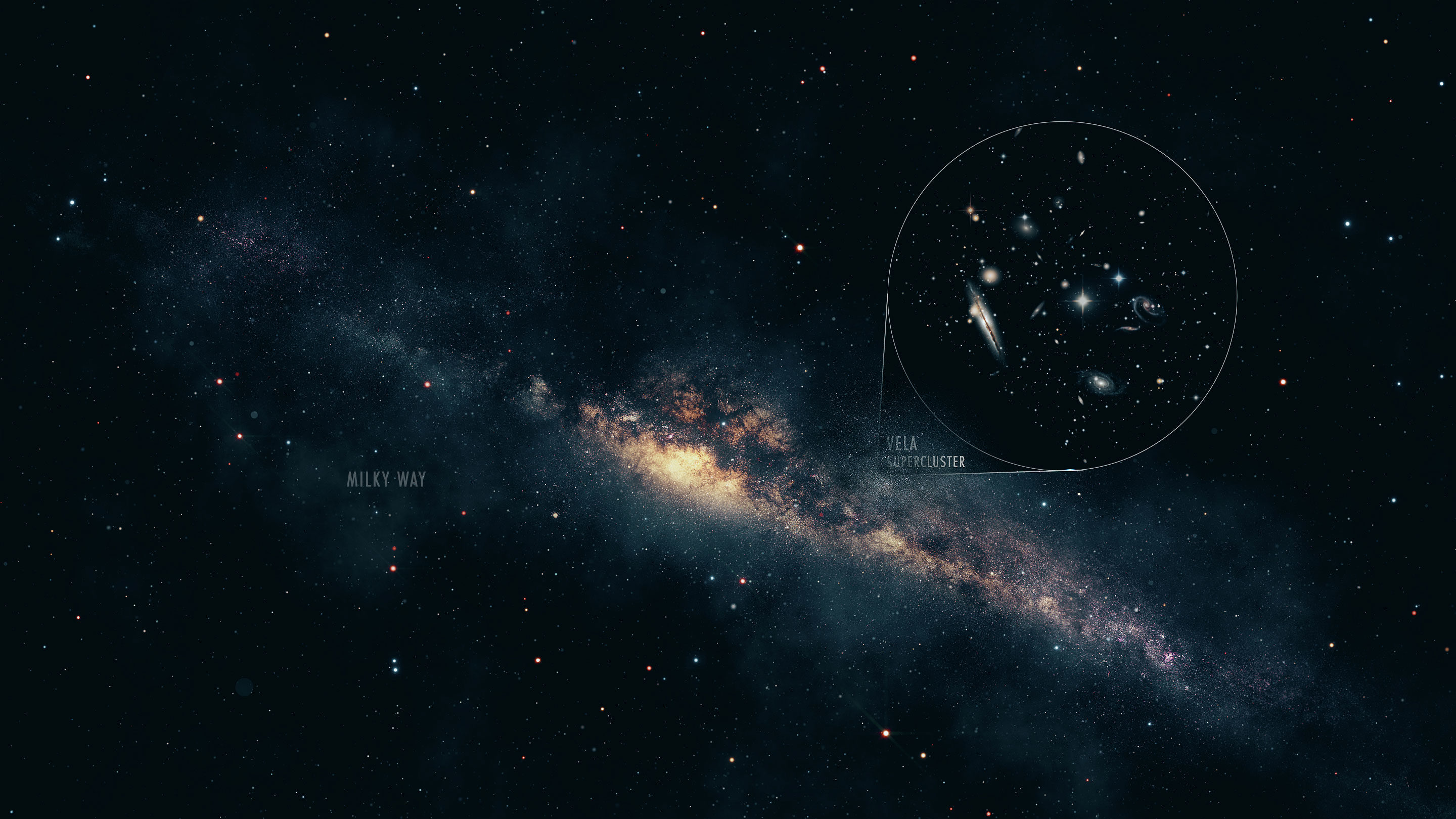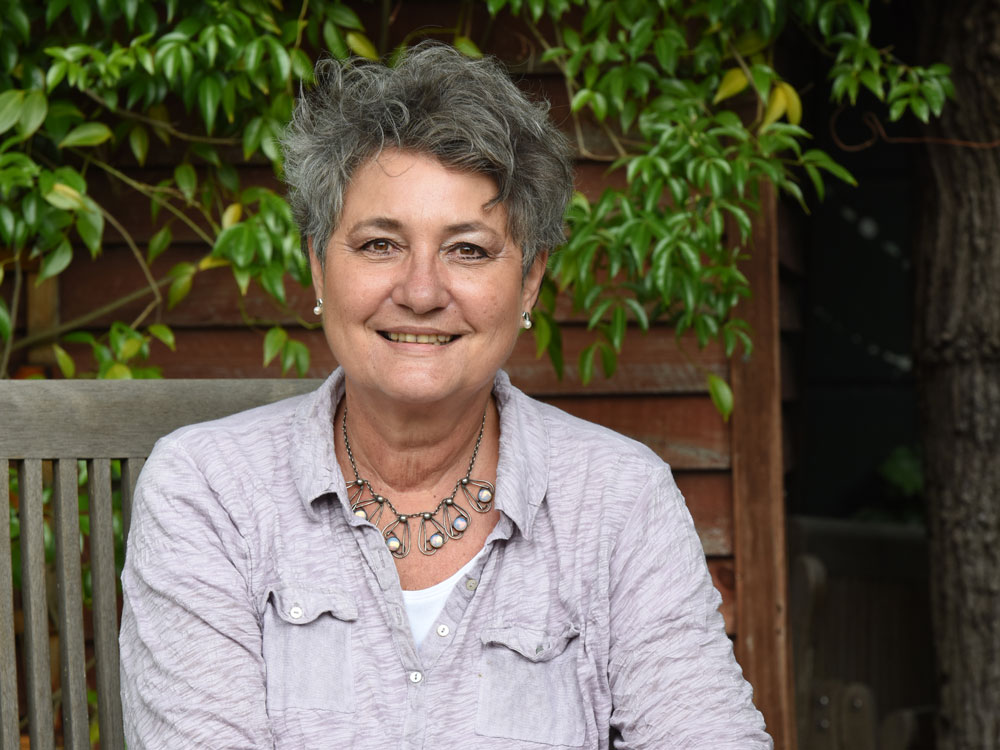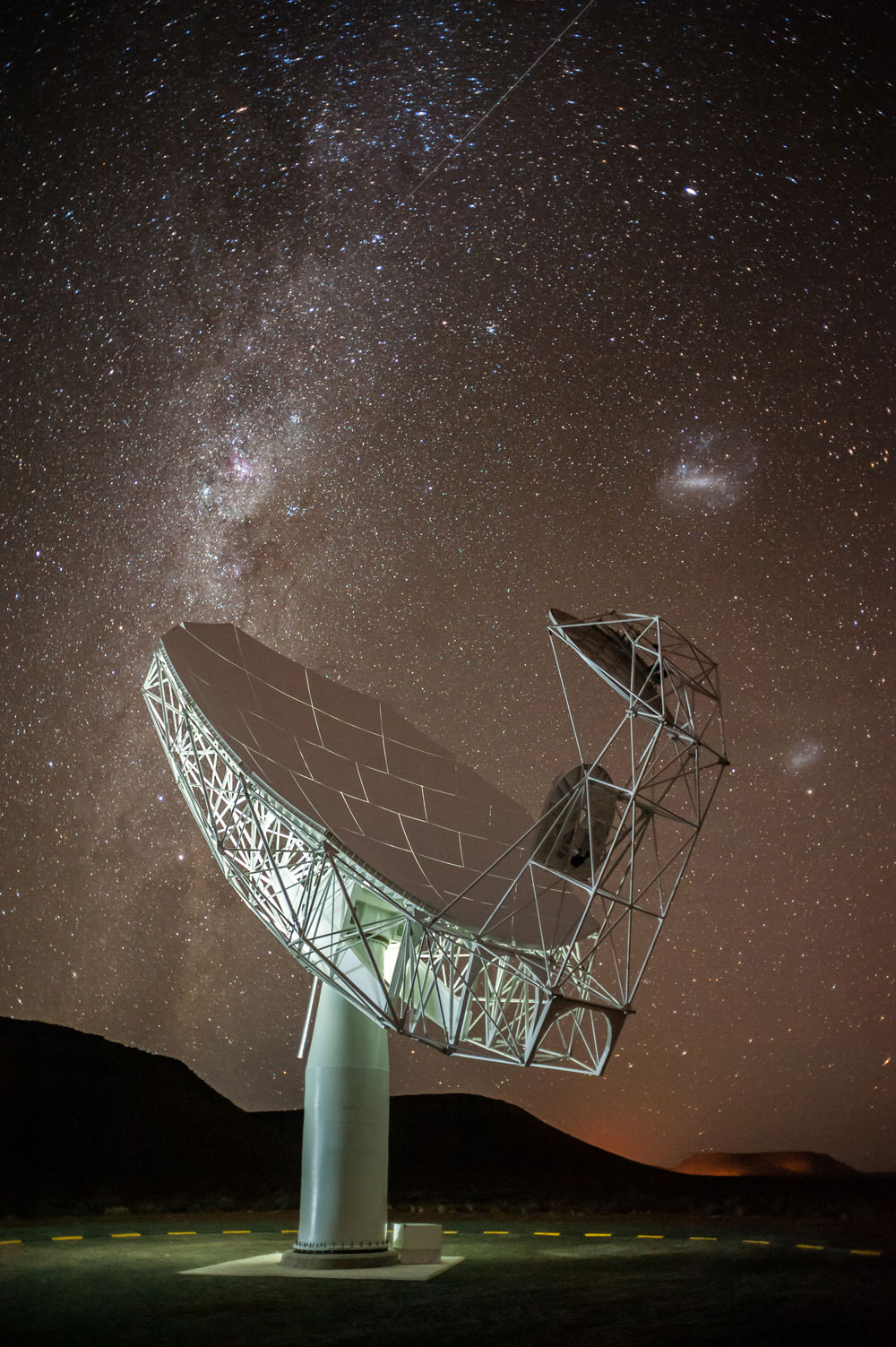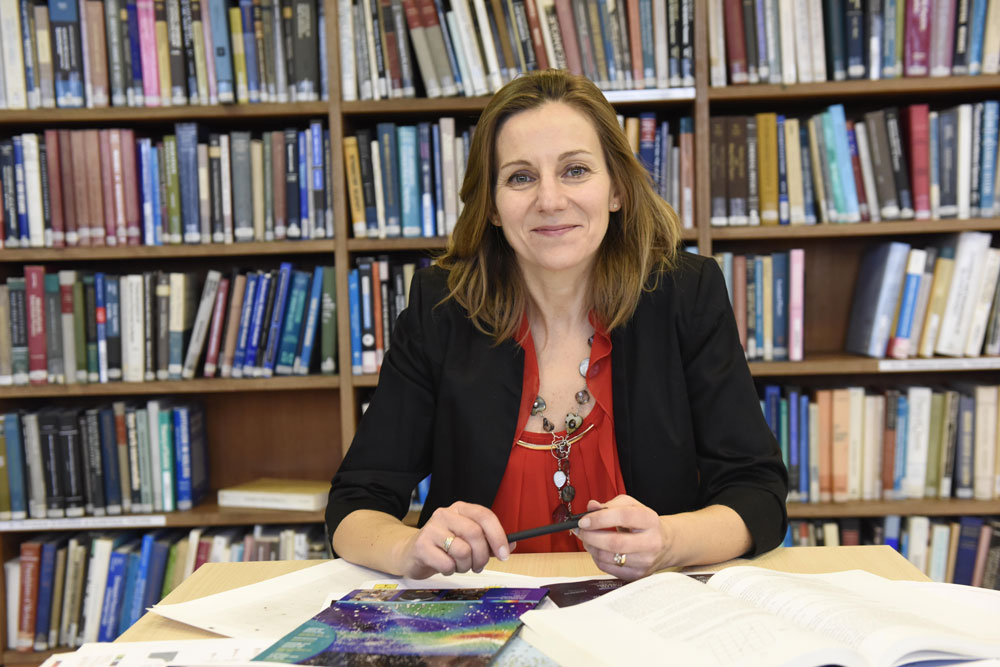Astronomers usually avoid the “Zone of Avoidance”. When one of them did not do this, she discovered a giant cosmic structure capable of explaining the too high speed of our galaxy.
 Image of Sails supercluster peeking from behind the Milky Way Avoidance Zone
Image of Sails supercluster peeking from behind the Milky Way Avoidance ZoneLook at the night sky from a place where there is a good overview, and you will see a thick strip of the Milky Way, stretching across the entire sky. But these stars and dust, describing the disk of our Galaxy, are not welcomed by astronomers studying the galaxies located behind ours. It looks like a thick strip of fogged windshield, a blur that makes our knowledge of the Universe incomplete. Astronomers call it a
zone of avoidance .
Rene Kraan-Korteweg [Renée Kraan-Korteweg] throughout her career tried to discover what lies behind this zone. For the first time, she found signs of something amazing in the background, when in the 1980s she discovered hints of a potential cluster of objects visible on old photographic plates. Over the next several decades, hints of large-scale structure continued to flow.
This year, Kraan-Korteweg and colleagues announced that they had discovered an enormous cosmic structure: a supercluster of thousands and thousands of galaxies. This group stretches for 300 million light years, and extends above and below the galactic plane, as a giant, hiding behind a lamp. Astronomers call this the
Sails supercluster , since it is located roughly at the site of the
constellation Sails .
 Rene Kraan-Korteweg, astronomer of the University of Cape Town
Rene Kraan-Korteweg, astronomer of the University of Cape TownThose who moved the Milky Way
The Milky Way, like all space galaxies, is moving. Everything in the Universe is constantly moving due to the expansion of the Universe itself, but since the 1970s, astronomers have been aware of one more motion, called the
peculiar velocity . This is a separate stream in which we are involved.
The local group of galaxies - which includes the Milky Way, Andromeda and a few dozen smaller neighbors - moves at a speed of 600 km / s relative to the residual radiation of the Big Bang.
Over the past few decades, astronomers have calculated everything that could pull and push the local group - nearby clusters of galaxies, superclusters, cluster walls and cosmic voids, which have a gravitational effect on our group, which cannot be neglected.
The largest tug is the
Shapley supercluster , a monster with a mass of 50 billion solar, located 500 million light years from Earth (and not very far on the celestial sphere from the Sails supercluster). It is responsible for 25-50% of the peculiar speed of the local group.
 Image of the Milky Way from the Gaia satellite, showing dark clouds of dust covering the view of the galaxies and the Universe behind them
Image of the Milky Way from the Gaia satellite, showing dark clouds of dust covering the view of the galaxies and the Universe behind themThe remaining motion cannot be explained by structures already discovered by astronomers. Therefore, astronomers continue to look farther and farther into the Universe, counting farther and farther objects that contribute to the overall gravitational pull of the Milky Way. Gravitational attraction decreases with increasing distance, but this effect is slightly lost due to the increase in the size of these structures. “The more the cards grow,” says
Mike Hudson , a cosmologist at the University of Waterloo in Canada, “the larger and larger objects people find on the edge of the visible space. We continue to look further and further, but more and more mountains are just beyond sight. ” So far, astronomers have taken into account only what is responsible for the speed of 450-500 km / s of the movement of the local group.
However, astronomers have still not sifted the Avoidance Zone with the same care. And the discovery of the Supercluster of the Sails shows that there may be something big there, just beyond our access.
In February 2014, Kraan-Korteweg and
Michael Claver , an astronomer from the University of the Western Cape Province of South Africa, set out to mark the Sails supercluster as part of an observation that stretched for six nights in the Anglo-Australian telescope in Australia. Kraan Korteweg knew where the densest accumulations of gas and dust were in the Avoidance Zone. She aimed at individual points where they had the best chance of seeing something right through this zone. The goal was to create a “backbone,” as she calls it, structures. Klaver, who already had experience with this tool, had to read the distances to individual galaxies.
This project helped them to conclude that the Sails supercluster actually exists, and that it occupies 20-25% of the sky. But they still do not know what is happening in its center. “We see walls crossing the Avoidance Zone, but for the place where they intersect, we do not yet have data due to dust,” said Kraan-Korteweg. How do these walls interact with each other? Did they start to merge? Is there a denser core hidden by the glow of the Milky Way?
And, most importantly, what is the mass of the Supercluster of Sails? After all, the mass is responsible for the gravitational attraction and the emergence of the structure.
How to see through the haze
Although the dust and stars of the Zone block light in the optical and infrared bands, radio waves can penetrate this region. With this in mind, Kraan-Korteweg developed a plan for using a space radio beacon to mark all that is behind the densest parts of the Avoidance Zone.
The plan is based on hydrogen, the simplest and most common gas in the universe. Atomic hydrogen consists of a single proton and an electron. These particles have such a quantum property as spin, which can be imagined as a small arrow attached to each of the particles [but it is better to imagine it as an angular momentum / approx. trans.]. For hydrogen-forming particles, these spins can point in one direction, or in opposite directions. Sometimes the spin changes direction - the parallel atom becomes antiparallel. When this happens, an atom emits a photon of light of a certain wavelength.
 One of the 64 antennas that make up the MeerKAT telescope in South Africa
One of the 64 antennas that make up the MeerKAT telescope in South AfricaThe probability of emission of such a radio wave by one atom is small, but if you collect a large amount of neutral hydrogen, then the total probability will increase. Fortunately for Kraan-Korteweg and her colleagues, many galaxies from the cluster of Sails have large reserves of such gas.
During observations in 2014, she and Claver saw signs that young stars were present in many of the galaxies they found. “And if there are young stars, this means that they have recently formed, which means that there is gas there,” said Kraan-Korteweg, since gas is the material from which stars are created.
The Milky Way also has its own hydrogen - another foreground haze that interferes with observations. But the expansion of the universe can be used to determine the radiation of hydrogen in the cluster of Sails. The expansion alienates the galaxies lying outside the local group and shifts the radio waves towards the red part of the spectrum. “These emission lines are separated, so they can be selectively counted,” says Thomas Jareth, an astronomer at the University of Cape Town who participated in the team that discovered the Sails supercluster.
And although the work of Kraan-Korteweg throughout her career has already discovered 5,000 galaxies in a supercluster, she is confident that a sufficiently sensitive radio observation of this neutral hydrogen can triple this amount and reveal the structures behind the densest part of the Milky Way disk.
This is where the MeerKAT radio telescope comes on the scene. It is located next to the small deserted city of Carnarvon in South Africa, and will soon become the most sensitive radio telescope on Earth. Its last, 64th antenna was installed in October, but for the time being several antennas need to be connected and checked. Half of the array of 32 plates will have to be earned by the end of 2017, and it will be fully operational at the beginning of 2018.
Kraan-Korteweg this year tried to get time for observations using this half-array, but if her request for 200 hours is not satisfied, she hopes to get 50 hours already on the full array. In both cases, the sensitivity will be the same, just such that it is required for them and their colleagues to detect the radio signals of neutral hydrogen from thousands of individual galaxies located hundreds of light years away from us. Armed with this data, they will be able to mark the full structure of the cluster.
Space catchments
Helen Courtois [Hélène Courtois], an astronomer from the University of Lyon, uses a different approach to markup superclusters. She makes maps of the universe, which she compares with the watersheds. In certain parts of the sky, galaxies migrate in one direction, just as rain in the catchment area flows into one lake or stream. They and their colleagues are looking for boundaries, on different sides of which matter is in different directions.
 Helen Courtois, astronomer from the University of Lyon
Helen Courtois, astronomer from the University of LyonA few years ago, Courtois and colleagues used this method to try to define our local large-scale structure called
Laniakey . Courtois explains the importance of defining this structure by the fact that although we have definitions of galaxies and galactic clusters, there is no universally accepted definition of large-scale structures of the Universe, such as superclusters and walls.
The problem, in particular, is that for a statistically rigorous definition, we simply do not have enough superclusters. We can list only known to us, but superclusters, as prefabricated structures consisting of thousands of galaxies, demonstrate an indefinite number of species.
Now Courtois and colleagues are shifting their attention further and further. “The sails are quite interesting,” says Courtois. “I want to measure the catchment of attraction, boundaries, frontier of the Sails.” She uses her own data to determine the currents moving towards the Sails and away from them, so that we can estimate the amount of mass attracted to them. By comparing these flow lines with the Kraan-Korteweg map showing the locations of the physical cluster of galaxies, they can estimate the Sail supercluster density and its size. “These two methods complement each other,” added Courtois.
The two astronomers are now jointly building the Sails map. Upon completion, they hope to be able to use it to determine the mass of the Sails, which will be the last piece of the puzzle movement of the local group - “this discrepancy has been haunting us for 25 years now,” said Kraan-Korteweg. And even if the supercluster is not responsible for the remaining motion, collecting signals of what is beyond the Zone of Avoidance will help to understand our place in the Universe.